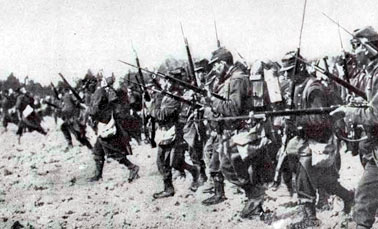You are ignorant. In the Napoleonic war almost no units used rifles. The few that did were using muzzle loaders with the same round balls the untitled muskets used.
Oh my dear lord. Are you even aware of what a rifle is?
A rifle is a firearm that uses a rifled barrel. Rifling put in place to cause a spin on the projectile, increasing range and accuracy.
It has not a damned thing to do with it being muzzle loaded or not. And neither does the shape of the projectile matter.
And yes, most Coalition forces did indeed use rifles. In fact, the French forces were the only side in the Napoleonic Wars that did not use rifles.
First, the British. The main firearm with the Royal Army was the Baker Rifle. First issued to all forces in 1801, it was still their standard weapon into the 1830's. A .625 caliber ball, this is unquestionably a rifle. Nor granted, the standard firearm for Colonial Forces was indeed the "Land Pattern Musket", a smoothbore commonly known as the "Brown Bess", but the forces deployed against Napoleon were most commonly issued the Baker.
I already discussed the Girardoni, a repeating rifle that was used by the Austrians and fired a .46 caliber ball. And yes, I know it was an air rifle. And if you think it was "fragile", try reading the Lewis and Clark journals. But while it had a 20 ball "clip", a shooter could fire on average 28-30 balls from a single flask. And the Austrians loved it because firing them did not obscure the battlefield with smoke, and they could be fired in all weather, and each rifle was also issued with a hand pump. So your stating that they issued "three flasks" is largely meaningless, as like with a musketeer they would have a "hip flask" to use on the battlefield. But also a larger one that would be used to refill it in their pack.
Now as "Germany" at that time was a fractured region of principalities, they did not actually have a unified military. But one of the most common ones were the "Jäger Rifles" units. And yes, as the name clearly says, they used rifles.
Like before, you seem to be confused. Rifles can be muzzle loaders, and can even fire ball projectiles. I used to hunt deer with a .50 caliber Kentucky Long Rifle I made myself. I fired round balls, and it was unquestionable a rifle.
Funny how you simply scream over and over I am "ignorant". But tell me, how many black powder weapons have you fired? For me, it is dozens and I have built 2 of my own. It was actually quite a passion of mine about 30 years ago, but I got out of it once I left North Carolina and sold them all to others. It was not exactly like I was going to be doing much deer hunting once I got transferred to the Bat area.
Now no need to tell me what a patch is, I very well know. But remember, you are trying to mix and match two very different eras of firearms here. And you just can not do that and expect to be taken seriously. You keep jumping to the Minié ball, a mid-19th century era creation. And apparently have some bad misconceptions about earlier era rifles. Such as they had to be "hammered in". That was simply not the case in standard operation, other than the simple fact that standardization was still often times questionable in that era. Most infantry typically made their own bullets, which were actually from molds they customized to fit their own guns. But in battle, I could see one having that issue if they had to replace their gun with one from another, or ran out of rounds and had to scavenge them from others.
But that had not a damned thing to do with rifle or non-rifle, that is simply how it was in that era when "standards" were absolutely nothing like they are today, and almost everything was hand made. And all muzzleloaders were "rammed". But ultimately, more than even the Minié ball it was the percussion cap that helped the widespread adoption of rifles. The US was already issuing rifles to their troops after the War of 1812, which was even breech loaded. Originally as a flintlock but quickly converted to percussion cap.
This is because at the time, most commanders valued speed over accuracy and firing in volley. And the difference in speed of smoothbore over rifle was on average 1 round per minute. 3-4 rounds per minute for rifle, 4-5 per minute for smoothbore. But replacing the flintlock with the faster and more reliable percussion cap allowed a percussion cap rifle to be loaded at the same speed as a flintlock smoothbore.
